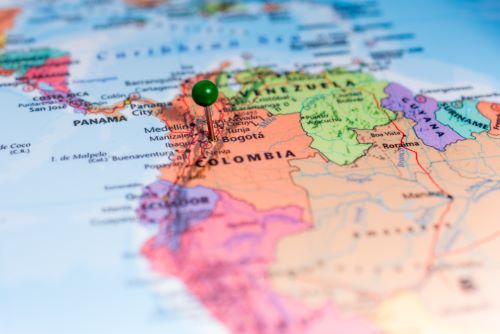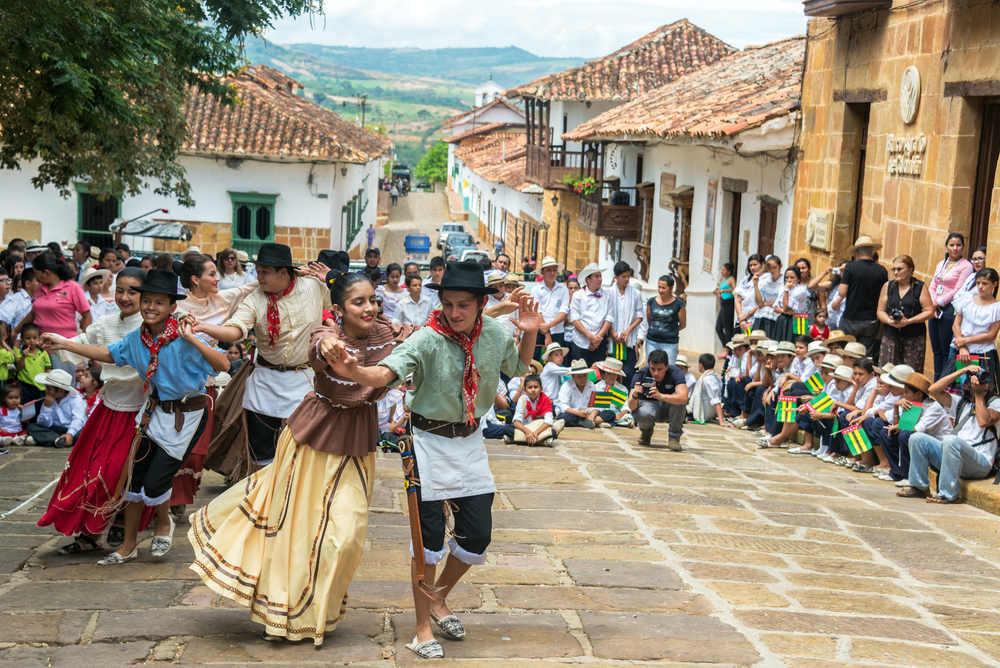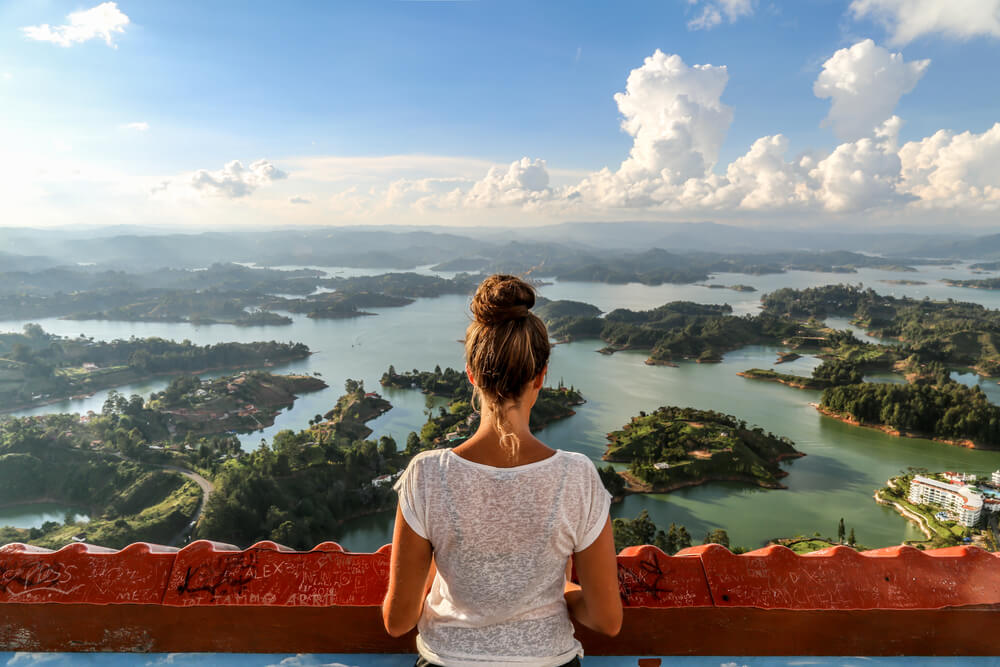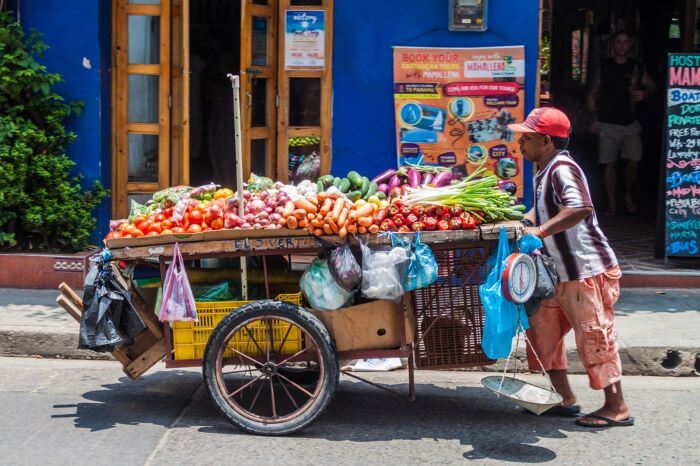Plan Your Visit
If you are planning to take a trip to Colombia, prepare in advance so that you do not miss any of the wonders that this country can give you.
For this reason, we have prepared this guide to help you prepare for your trip to Colombia. From weather tips to must-see tourist destination suggestions and safety recommendations. Therefore, we are here to make your trip as pleasant and hassle-free as possible.

BEFORE YOU GO
Prepare some local cash
The official currency of Colombia is the Colombian Peso, abbreviated as COP. It’s important to be familiar with the currency and its denominations, especially when engaging in transactions, whether it’s shopping, dining, or using transportation services. Make sure to check the current exchange rates and inform your bank of your travel plans to avoid any issues with your credit or debit cards while in Colombia.
If you have to exchange currency while in Colombia, the safest place to do so are the larger banks, like Banco de Bogota, Bancolombia, and Davivienda, which typically offer currency exchange services. Do not forget to present your passport when exchanging currency.
Another option are the Casas de cambio or exchange offices which, sometimes offer better rates than the banks and have more flexible working hours.
At all price avoid exchanging money on the street from non-regulated businesses.
Prepare some local cash
You will find a wide variety of accommodation options to suit different travel styles and budgets in Colombia. Here are some of the most common options:
Hotels
Colombia has a plethora of hotel options in its major cities and tourist destinations. Prices and services vary depending on the hotel category, which can range from budget hotels to luxury accommodations. The main tourist destinations offer a range of facilities – resorts suitable for family vacations like Hyatt Regency Cartagena, Four Seasons Bogota, or Sofitel Barú Calablanca, top business hotels like DoubleTree or Nacar Hotel run by Hilton.
There are also a lot of budget-friendly options like the low-cost hotel chain Ibis.
Hostels & Hostels
If you are looking for an alternative accommodation ways, platforms like Airbnb or Booking.com offer a large range of private apartments for budgeted stays. For travelers on a budget or those who prefer a more social experience, hostels and hostels are a great option. These accommodations usually offer shared and private rooms at affordable prices.
Vacation Rentals & Apartments
In cities like Bogota, Medellin, and Cartagena, you’ll find a variety of apartments and vacation rentals for short or extended stays. This option is ideal for those who want more space and additional amenities, such as a kitchen and laundry.
Rural lodges and eco-lodges
For those looking for an experience closer to nature and local culture, rural lodges and eco-lodges are an excellent option. These accommodations often offer an authentic experience and are located in picturesque settings.
Inns & Guest Houses
In less touristy towns and areas, you’ll find inns and guesthouses run by local families. These accommodations offer a home-based, cozy experience, and often include home-cooked meals prepared with local ingredients.
Great camping sites
For nature and adventure lovers, some natural areas in Colombia offer camping and glamping options. These options allow visitors to enjoy the country’s natural beauty while connecting with the surroundings. Los Nevados National Park, is where the Cocora Valley and the city of Salento are. This is Colombian coffee cultural center, an amazing blend of local coffee plantations, cozy town, and beautiful nature. If you like hiking, the Cundinamarca region is perfect for you. Situated some 9,800ft/3,000m above the sea lever, this place offers fantastic view over the Laguna de Suesca and the city of Suesca – a small and beautiful colonial city.
Couchsurfing
Another low-cost option, can also be a great way to connect with locals, experience authentic culture, and save money on accommodation. However, it’s important to prioritize safety and take precautions to ensure that your Couchsurfing experience is legitimate.

Get familiar with the local customs and habits
- Languages: The official language spoken in Colombia is, of course, Spanish. Although at the tourist areas you can cope with English, Spanish continues to be largely used even there. This is why we advise you to learn some basic Spanish to shorten the distance with the local people.
- Greeting: People in Colombia are generally friendly and warm. When meeting someone for the first time, a handshake is a common greeting. Close friends and family members often exchange kisses on the cheek.
- Punctuality and time: Well, time varies. Colombians tend to have a more relaxed attitude toward time, especially in social situations. While punctuality is appreciated, there might be some flexibility in meeting times.
- Respect personal space: Colombians value personal space, so maintain an appropriate distance when engaging in conversations. Avoid standing too close to someone unless you have a close relationship.
- Be polite: Politeness is important in Colombian culture. Use “Por favor” and “Gracias” when appropriate. Being polite is highly valued in social interactions. While many Colombians in tourist areas speak English, learning some basic Spanish phrases can go a long way in enhancing your interactions and showing respect for the local language.
- Eating with friends: When invited to someone’s home, it’s customary to bring a small gift or dessert. During meals, wait for the host to start before you begin eating. Finish your entire plate to show appreciation for the meal.
- Beach etiquette: It is important not to leave trash behind and to respect the wildlife on the beach areas. If you plan to take spirits with you, better check the local regulations under which he beach you are heading to is. The same applies if you will take music. Nudity as a whole is not accepted on Colombian public beaches.
- Dress Code: In certain areas, especially rural or conservative regions, it’s advisable to dress conservatively. When visiting religious sites, consider wearing more modest clothing and avoid short pants and dresses, and naked shoulders.
- Use of “Usted”: When addressing someone in a formal or respectful manner, use the formal “Usted” instead of the informal “tú.” This is especially important when speaking with older individuals or those in positions of authority.
- Small Talk: Colombians are generally sociable and enjoy conversation. Be ready to be asked questions. It will be appreciated if open to engaging with locals, asking questions, and sharing your experiences.
- Local events: Colombians often celebrate cultural events and festivals with enthusiasm. If you have the opportunity to attend such events, join in the festivities and enjoy the local culture.
- Crowds and Prices: The high season tends to attract more tourists, leading to higher accommodation prices and more crowded attractions. If you prefer quieter travel experiences and are willing to tolerate occasional rain, the low season may be a good option.
Choose the best time to travel to Colombia
It all depends of what you plan to do. As Colombia is a country of diverse climates and regions, so the best time to visit depends on your preferences for weather and activities. Generally, Colombia has two main seasons: the dry season (high season) and the rainy season (low season). Here are some considerations for each season:
Dry (Hight) Season – December to March & June to August: The dry season is the most popular time to visit Colombia, especially for those wanting to explore various regions. This period offers more stable weather, making it ideal for outdoor activities, hiking, and sightseeing. Coastal areas like Cartagena and Santa Marta experience dry and sunny weather during these months.
Rainy (Low) Season – April to May & September to November: The rainy season can vary in intensity and duration depending on the region. While some areas experience short, heavy showers, others may have more consistent rainfall. The Amazon rainforest and parts of the Andean region can be wetter during this period. However, the rainforest can be especially lush and vibrant during the rainy season.
What to expect when visiting
- The Caribbean Coast: The dry season is an excellent time to visit coastal areas like Cartagena and Santa Marta for beach activities and water sports.
- The Andean Region: Bogotá and Medellín experience a more consistent climate throughout the year, but the dry season is generally preferred for outdoor activities in the Andean region.
- The Amazon Rainforest: The rainy season can bring higher water levels, making boat travel easier in some areas. However, it also means more mosquitoes, so be prepared with appropriate clothing and insect repellent.
ONCE THERE

On the streets
Street vendors are a common sight in Colombia. They offer a variety of goods and services, from food and beverages to handmade crafts and souvenirs. Interacting with street vendors can add to your cultural experience, but it’s essential to be aware of certain considerations:
Bargaining: Bargaining is a common practice in many Colombian markets and when dealing with street vendors. However, it’s important to do so respectfully. Understand that some vendors may rely on their sales for their livelihood, so negotiate fairly.
Quality and Authenticity: When purchasing items from street vendors, especially handmade crafts or souvenirs, inspect the quality and authenticity. Some vendors may sell mass-produced items, while others offer unique, locally made products.
Hygiene and Food Safety: If you plan to buy food from street vendors, observe their hygiene practices and the cleanliness of their setup. Choose vendors with a clean and organized appearance to minimize the risk of foodborne illnesses.
Local Currency: Street vendors often prefer cash transactions. Have small denominations of local currency to make purchases, and be cautious about using large bills, as some vendors may not have enough change.
Respectful Interaction: Approach street vendors with respect and courtesy. If you’re not interested in making a purchase, a polite “no, gracias” is sufficient. Avoid aggressive or dismissive behavior.
Local Recommendations: Locals often know the best and most reputable street vendors. If you’re unsure where to buy certain items, ask locals for recommendations to ensure a positive experience.
Legal Considerations: Some areas may have specific regulations regarding street vending. Be aware of local laws and guidelines to ensure that your interactions with street vendors are legal and respectful.
Support Local Artisans: If you’re interested in supporting local artisans, look for street vendors selling handmade crafts or traditional products. These purchases can contribute to the livelihoods of local communities.
Be Mindful of Your Belongings: While many street vendors are honest and trustworthy, it’s advisable to be mindful of your belongings, especially in crowded areas. Keep your valuables secure to prevent theft.
Cultural Sensitivity: Be culturally sensitive when interacting with street vendors. Understand and appreciate the local customs and traditions, and be open to learning from the vendors about their products and culture.
Shopping and tipping
Colombia is an attractive place to go shopping. From modern shopping centers to small businesses and street markets you can find an exciting range of international local goods.
Shopping
Markets and Street Vendors: Colombia has vibrant markets where you can find handmade crafts, textiles, and local products. Bargaining is common in markets, so feel free to negotiate prices, especially when dealing with street vendors.
Shopping Malls: Major cities in Colombia, such as Bogotá, Medellín, and Cartagena, have modern shopping malls where you can find a wide range of international and local brands.
Local Souvenirs: Consider buying traditional Colombian items like handicrafts, coffee, emeralds, and traditional clothing as souvenirs.
Payment Methods: Credit and debit cards are widely accepted in urban areas and tourist destinations. However, it’s advisable to carry some cash, especially in smaller towns or for transactions with street vendors.
Tipping
Tipping is a common practice in Colombia, and it’s generally appreciated for good service. While tipping is not mandatory, it is customary in restaurants, cafes, and for various services. Here are some tipping guidelines:
Restaurants: It is common to leave a tip of 10 to 15% of the total bill in restaurants, especially in more formal or touristy places.
Taxi drivers: Taxi drivers are not expected to tip, but many customers round up the fare to the nearest value as a gesture of courtesy.
Hotel services: In hotels, it’s common to leave tips for housekeeping staff and bellhops. It is recommended to leave between:
- 2000 and 5000 Colombian pesos per day for cleaning staff
- 5000 and 10000 Colombian pesos per suitcase for the bellboys.
Tour guides: If you have enjoyed a guided tour or excursion, it is appropriate to leave a tip for the guide. The amount can vary, but between $10,000 and $20,000 COP per person is recommended.
Balls and goalkeepers: In establishments such as discos, bars, and nightclubs, it is common to tip the service staff who serve you during the night. The amount may vary depending on the level of service and the type of establishment.
Colombian street vendors

Interacting with street vendors in Colombia can be an enriching cultural experience. Of course, it is important to take into account some considerations, such as:
Fair Negotiation
This practice is common in Colombian street markets. However, be sure to negotiate fairly and respectfully, acknowledging the value of the seller’s work and avoiding excessive haggling.
Safety & Quality
When buying products from street vendors, check the quality and authenticity of the products before making a purchase. Also, keep your belongings safe and keep an eye on your surroundings to avoid any risky situations.
Supporting the local
Prioritize buying artisanal products from local street vendors. This will be to support the local economy and small businesses.
Cultural respect
Respect local traditions and customs when interacting with street vendors. Therefore, learn some basic phrases in Spanish and show genuine interest in Colombian culture while communicating with them.
Pricing Awareness
Before you buy, research the average prices of the products you’re interested in to avoid paying too much price. Also, it’s a good idea to keep a fair value of the product in mind.
Conscious Shopping
Before you buy, consider whether you really need the product and whether you’re willing to take it with you during your trip. Therefore, prioritize purchases that provide you with value and meaningful experiences.
THE TRAVEL DOCUMENTS
- Valid passport: Make sure your passport is valid for your entire trip to Colombia and has at least six months of validity remaining.
- Visa (if applicable): Depending on your nationality, you may need a visa to enter Colombia. Check the specific visa requirements for your country at the nearest Colombian embassy or consulate.
- Check MIG for Colombia: Whether traveling with a regular visa or visa-free, do not forget to register for Check MIG and get your document before heading to Colombia.
- Travel insurance: Although not mandatory, it is recommended to obtain travel insurance that covers medical expenses, emergency medical evacuation, and loss or theft of belongings during your stay in Colombia.
- Vaccinations: Check to see if specific vaccinations are required to enter Colombia based on your country of origin and the places you plan to visit. Make sure you’re up to date on recommended vaccinations, such as yellow fever.
- Cash and credit cards: Make sure you carry enough cash in the local currency (Colombian pesos) for your initial expenses, as you may not easily find exchange offices at the airport.
